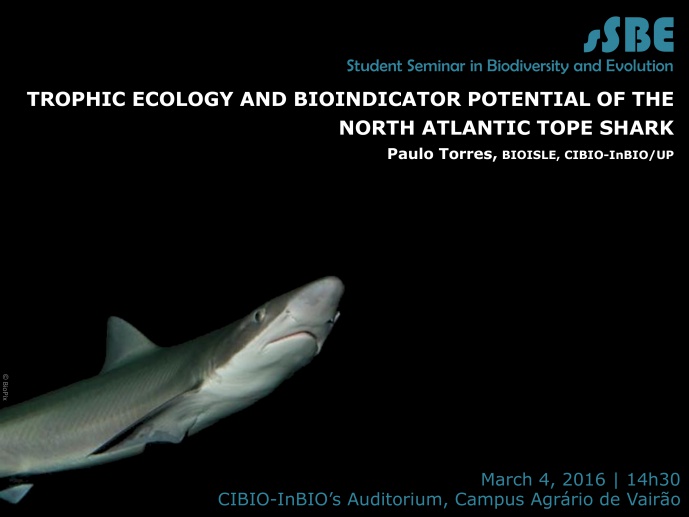TROPHIC ECOLOGY AND BIOINDICATOR POTENTIAL OF THE NORTH ATLANTIC TOPE SHARK

STUDENT SEMINAR IN BIODIVERSITY AND EVOLUTION

Sharks are marine top predators vital in maintaining ecosystem health and food web structure. In order to assess tope shark (Galeorhinus galeus) trophic ecology, stable isotope ratios and trace metal concentrations in muscle tissue were determined, according to size and gender, for 124 individuals caught within the Mid-Atlantic region. Data was complemented and analysed according to previous stomach content information and compared with studies performed in the North East Atlantic. Our results revealed that tope sharks fed at a low trophic level and within a more pelagic-based food web when compared with other North Atlantic regions. MixSIR application reflected its piscivorous diet and study area topography, oligotrophic waters and volcanic nature, suggesting the occurrence of a Mid-Atlantic tope shark population. Considering a non-anthropogenic volcanic source for observed metal contents, the results reflect bioaccumulation and suggest biomagnification processes for As and Hg. These metals exceeded legislated maximum limits for some countries with a maximum of 28.98 ± 1.26 and 0.57 ± 0.01 mg kg-1 wet weight, respectively, increasing significantly with size for both males and females. Conversely, Cr, Rb and Zn were relatively stable while Cd and Pb were not detected. Hg and Se were strongly correlated, suggesting a Se toxicity mitigation role. Given tope shark travel capacity and the results obtained, the species may be used as a Mid-Atlantic bioindicator of environmental quality.
Paulo Torres, born in 1982 in Lisbon, Portugal, has a Degree in Marine Biology and a Master in Assessment and Management of Marine Resources. During his academic career he had the opportunity to actively participate in two international projects financed by the European Union, the PUMPSEA project (Peri-urban mangrove forests the filters and potential phytoremediators of domestic sewage in East Africa) and TRANSMAP project (Transboundary networks of marine protected areas for integrated conservation and sustainable development: biophysical, socio-economic and governance assessment in East Africa). More recently attended the INSPECT project (Alien Species Marine introduced in estuaries and Portuguese coastal areas: patterns of distribution and abundance; vectors; and potential invasion). Today he is developing his PhD project regarding elasmobranchs (sharks and rays) in the Azores, evaluating and analysing ecotoxicological effects of some pollutants on these populations and exploring their potential for ecotourism purposes in the region. The PhD thesis under a title “Elasmobranchii (sharks and rays), a potential resource to protect in the Azores” is supervised by Prof. Regina Tristão da Cunha from the Research Center in Biodiversity and Genetic Resources (CIBIO), University of the Azores, and co-supervised by Prof. Armindo Rodrigues from the Centre of Volcanology and Geological Hazards Assessment (CVARG), University of the Azores, and Dr. Rui Coelho from the Portuguese Institute for the Ocean and Atmosphere (IPMA).
Image credits: BioPix